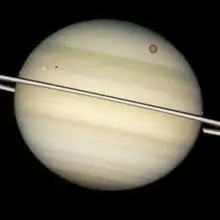Solar eclipses on Saturn
Solar eclipses on Saturn occur when the natural satellites of Saturn pass in front of the Sun as seen from Saturn.

For bodies which appear smaller in angular diameter than the Sun, the proper term would be a transit and which are larger than the apparent size of the Sun, the proper term would be an occultation.
Seven of Saturn's satellites – Janus, Mimas, Enceladus, Tethys, Rhea, Dione and Titan – are large enough and near enough to eclipse or occult the Sun, or in other words to cast an umbra on Saturn. Most of the more distant satellites, besides being tiny, have orbits that are strongly inclined to the plane of Saturn's orbit, and would rarely be seen to transit.
At this distance, the sun covers only about 3 arcminutes in the sky of Saturn. In comparison, the seven major moons of Saturn have angular diameters of 5–10' (Mimas), 5–9' (Enceladus), 10–15' (Tethys), 10–12' (Dione), 8–11' (Rhea), 14–15' (Titan), and 1–2' (Iapetus). Iapetus is Saturn's third largest moon, but is too far away to completely eclipse the sun. Janus, a very close moon to Saturn, has an angular diameter of about 7', meaning that it can fully cover the sun.
Unlike Jupiter, Saturn has a moderate axial tilt of 26.7 degrees. This means that solar eclipses on Saturn are much more rare than solar eclipses on Jupiter.
.jpg.webp)


.jpg.webp)